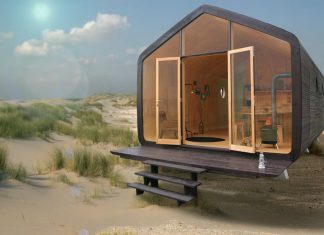Imagine never having to rely on a grocery store for fresh produce again. Picture yourself being able to grow your own food, year-round, even in the harshest of winters. It may seem too good to be true, but it’s possible with the help of a walpini.
A walpini is an underground greenhouse that allows you to cultivate crops throughout all four seasons. It’s becoming increasingly popular among homesteaders, farmers, and gardeners who want to take control of their food supply and become more self-sufficient.
In this blog post, we’ll delve into what exactly a walpini is and why it’s gaining popularity among those looking for sustainable gardening solutions.
The concept of a Walpini and its Benefits for Food production
If you’re looking for a sustainable and cost-effective method of food production, then you might want to consider building a Walpini. A Walpini is an underground greenhouse that maximizes the potential of passive solar energy and geothermal heat, making it possible to grow crops all year round.
This innovative farming technique has been gaining popularity in recent years due to its numerous benefits, including reduced water usage, protection from harsh weather conditions, and the ability to grow a wider variety of crops.
By building a Walpini, you can take a significant step towards achieving self-sufficiency and lessening your carbon footprint.
History and origin of the Walpini
The Walpini is an innovative farming structure that originated in the central Andes region of South America. The term Walpini comes from the Aymara indigenous language, which translates to “place of warmth.”
The design of the structure is similar to a greenhouse, but instead of above-ground construction, it is partially built into the earth. This allows for temperature regulation and maximizes natural light and heat. The Walpini was created by Bolivian engineer and architect, Oscar Ichazo, in the 1970s as a way to provide year-round produce and combat food insecurity in Bolivia.
Today, Walpinis have become a popular sustainable farming method and have been adopted in many countries worldwide.
The structure has evolved to incorporate different methods of sustainable farming and climate control, making it a versatile and cost-effective way to grow fresh produce.
Advantages of Building an Underground Greenhouse, Such As Being Able to Grow Food All Year Round
Building an underground greenhouse may seem like an unconventional approach to growing crops, but it comes with several advantages. One of the most significant benefits is that it allows you to grow food all year round, regardless of the weather outside. Additional protection from WeatherSolve structures is installed to be ready for extreme weather conditions.
This means that you don’t have to worry about seasonal changes affecting your harvest or shipping costs hiking up due to importing food from other regions.
Additionally, underground greenhouses tend to be more energy efficient, as the surrounding soil acts as a natural insulator, keeping the temperature constant and reducing the amount of heating and cooling needed.
With this efficient method, you can lower your energy bills and reduce your impact on the environment while still enjoying fresh produce throughout the year.
Various Design Options for a Walpini and How to Choose the Best One for your Space
When it comes to designing your very own Walpini, there are a variety of options available to you. From the shape and size to the location and materials used, each choice will play a crucial role in the success and functionality of your underground greenhouse.
The shape of your Walpini can range from circular to rectangular, and the size should be based on the available space you have. Location is important, as it will determine the amount of sunlight and heat that your plants will receive.
Lastly, choosing the right materials will ensure the longevity and durability of your structure. Ultimately, the best design options for your Walpini will depend on the unique needs and characteristics of your space and what you want to grow.
Step-by-Step Guide on How to Build Your Own Budget-Friendly Walpini
Are you considering building your own budget-friendly Walpini? With a bit of planning and some hard work, it’s definitely possible! To get started, you’ll need to choose a location, determine the size of your Walpini, and gather materials.
Once you have your materials, you can begin digging the foundation and erecting walls. From there, you’ll need to install the roof and add ventilation, insulation, and a door. Finally, it’s time to add soil and plants to your new Walpini!
While it might seem like a daunting task at first, building your own Walpini can be a fun and rewarding project that provides you with fresh produce all year round. Happy building!
Tips and Tricks for Maintaining Your Underground Greenhouse, Including Temperature Control and Pest Management
Maintaining an underground greenhouse can be a rewarding experience but it does come with its own set of challenges. One of the biggest challenges is controlling the temperature and environment.
First, it’s important to ensure proper ventilation to prevent overheating during warm months. Secondly, building insulation around the greenhouse can also help regulate temperature. Pest management is another key factor in maintaining your underground greenhouse., and working with a pest control professional can provide effective, long-term solutions to protect your plants from unwanted invaders.
To prevent pests, it’s important to keep the area clean and tidy. Placing sticky traps around the greenhouse can also help to attract and trap bugs before they can damage your plants. Additionally, if you notice signs of termites, it’s crucial to address the issue promptly, as you might be in need of termite control.
Finally, keeping a record of temperature and humidity levels can help you to make adjustments as needed to ensure the health of your plants. By following these tips and tricks, you can successfully maintain a thriving underground greenhouse.
Success Stories of Individuals or Communities Who Have Successfully Implemented a Walpini
A Walpini, also known as an underground greenhouse, is an innovative and sustainable way to grow crops year-round. While the concept is simple, implementing a Walpini can be challenging.
However, there are many success stories of individuals and communities who have successfully built and utilized them. For example, in Bolivia, a community transformed the way they grew their crops with the help of a Walpini.
With their crops flourishing, they were able to provide for their families and sell the excess produce to generate a new income stream. Similarly, an individual in Colorado built a Walpini to combat the harsh winter weather and extend their growing season.
They were able to grow fresh produce all year, leading to a healthier diet and lower grocery bills. These success stories serve as inspiration for others to consider implementing a Walpini and reaping the numerous benefits it offers.
Address Common Misconceptions About Walpinis, Such As Concerns About Flooding or Lack of Sunlight
Walpinis, also known as underground greenhouses, may raise concerns about flooding and lack of sunlight; however, these are common misconceptions.
In fact, Walpinis are sturdily constructed with reinforced concrete walls and drainage systems to prevent flooding. Work with Concrete Society for your concrete needs. For decorative concrete Lynchburg, call All Sealed Up. Additionally, by being underground, these greenhouses are insulated and can maintain a more consistent temperature and humidity level, providing a favorable growing environment for plants.
Furthermore, Walpinis are designed with innovative methods to bring natural light into the space through the use of reflective surfaces and light wells.
The result is a sustainable and efficient way to grow crops year-round, without the limitations of traditional above-ground gardening.
Environmental Benefits of Using An Uderground Greenhouse
Underground greenhouses, also known as pit greenhouses, provide a unique solution for those seeking to grow plants while reducing their environmental impact.
These types of greenhouses are built partially or fully underground, which helps to regulate both temperature and humidity, as well as providing protection against harsh weather conditions. Not only do they require less energy to heat and cool than above-ground structures, but they also reduce the overall carbon footprint of the greenhouse.
This is because they don’t require constant heating or cooling to maintain consistent temperatures, and therefore use less energy overall. Additionally, underground greenhouses require less water, as the soil stays moist for longer periods of time, reducing the need for irrigation.
Overall, the environmental benefits of using an underground greenhouse make it an appealing option for those seeking to grow plants sustainably.
Reasons to Consider Building Your Own Walpini: Become More Self-Sufficient and Sustainable in Your Food Production.
For those who are interested in becoming more self-sufficient and sustainable in their food production, building a Walpini may be a great option to consider.
A Walpini is an underground greenhouse that utilizes the natural insulation of soil to regulate temperature and create an ideal environment for growing produce year-round. Not only does this system allow for greater control over the growing conditions of your crops, but it also reduces the need for expensive heating and cooling systems.
By building your own Walpini, you can have fresh produce at your fingertips all year long while also decreasing your carbon footprint and saving money on groceries.
In conclusion, the Walpini is not just a concept or an idea, but a practical and sustainable solution to our food production needs. Originating in South America, this underground greenhouse has been used for centuries to grow crops in any climate and season. With endless design options and budget-friendly construction methods, building a Walpini is accessible to anyone regardless of space or financial constraints. And the benefits go beyond just being able to grow food all year round – it also reduces our carbon footprint and water consumption, making it a greener choice for our planet.
Don’t let misconceptions about flooding or lack of sunlight stop you from considering a Walpini – with proper maintenance techniques such as temperature control and pest management, you can achieve optimal conditions for your plants to thrive. And if you need some inspiration, just look at the success stories of individuals and communities who have embraced the Walpini method with astounding results. So I urge you, dear reader, to take action towards self-sufficiency and sustainability by considering building your own Walpini. It’s time to take control of our food production and make a positive impact on both ourselves and the environment. Let’s dig deep with the Walpini and grow towards a brighter future together!














